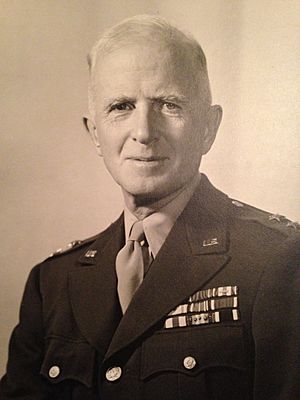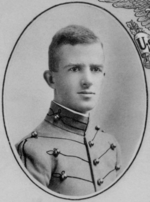Orlando Ward facts for kids
Quick facts for kids
Orlando Ward
|
|
|---|---|
 |
|
| Born | November 4, 1891 Macon, Missouri, United States |
| Died | February 4, 1972 (aged 80) Denver, Colorado, United States |
| Buried |
Fairmount Cemetery, Denver, Colorado, United States
|
| Allegiance | |
| Service/ |
|
| Years of service | 1914–1953 |
| Rank | |
| Service number | 0-3729 |
| Unit | |
| Commands held | 2nd Battalion, 10th Field Artillery Regiment 1st Battalion, 83rd Field Artillery Regiment 1st Armored Brigade 1st Armored Division United States Army Field Artillery School 20th Armored Division 6th Infantry Division V Corps |
| Battles/wars | Pancho Villa Expedition World War I World War II |
| Awards | Distinguished Service Cross Army Distinguished Service Medal Silver Star Purple Heart Legion of Merit (2) |
| Signature | |
Major General Orlando Ward (born November 4, 1891 – died February 4, 1972) was an important U.S. Army officer. He served in both World War I and World War II.
During World War II, he led the 1st Armored Division. This was during the invasion of North Africa and the early parts of the Tunisian campaign. Later, he commanded the 20th Armored Division in Europe. Ward also worked closely with General George C. Marshall, a top U.S. Army leader. He helped improve how field artillery worked, which was very useful in World War II.
Contents
Early Life and Military Start
Orlando Ward was born in Macon, Missouri, on November 4, 1891. When he was 18, he joined the U.S. Military Academy at West Point, New York in 1909. He graduated on June 12, 1914, as a second lieutenant in the Cavalry Branch. Many of his classmates also became generals.
Ward's first job was leading black cavalry troops. He served on border patrol in Arizona and New Mexico. In 1916, he chased Pancho Villa into Mexico with Brigadier General John J. Pershing's forces. He earned the Mexican Service Medal for this. Ward then became interested in artillery because he saw that horses would not be as important in future wars. He switched to the Field Artillery Branch.
The United States joined World War I in April 1917. Ward's unit, the 10th Field Artillery Regiment, became part of the 3rd Infantry Division. He fought on the Western Front in Europe. During the Second Battle of the Marne in July 1918, he bravely took charge of his battalion. He kept them fighting effectively against the Germans. For his actions, he received the Silver Star Citation. He continued to serve until the war ended on November 11, 1918.
Between the Big Wars
After World War I, Ward stayed in the field artillery. He worked as an instructor for the ROTC at the University of Wisconsin–Madison. Later, he taught at the U.S. Army Field Artillery School in Fort Sill, Oklahoma. There, he helped create new ways for soldiers to observe and direct artillery fire. These methods made American artillery very powerful in the next war.
He also attended the United States Army War College from 1935 to 1936. During this time, he was promoted to lieutenant colonel. After graduating, he led the 1st Battalion, 83rd Field Artillery Regiment. Then, he worked as a staff officer for the War Department for several years.
World War II Service
From July 1939 to August 1941, Ward was the Secretary to General George C. Marshall. Marshall was the top U.S. Army leader. This was a very important time as the U.S. prepared for World War II. Ward helped Marshall find resources to build up the military. He worked to support Britain even as some politicians wanted the U.S. to stay out of the war. During this time, he was promoted to colonel in December 1940 and then to brigadier general in August 1941. Soon after, he took command of the 1st Armored Brigade.
North Africa Battles
In March 1942, Ward became the commander of the 1st Armored Division. This was three months after the U.S. joined World War II. The division went to Northern Ireland in May. They practiced with the British Army there. In November, Ward led his division across the Atlantic Ocean to French North Africa. This was part of Operation Torch, the Allied invasion.
The 1st Armored Division faced tough challenges against German forces in the Tunisian Campaign. The division was split up into smaller groups by British and American commanders. This made it harder for them to fight as one strong unit. In December 1942, many of their tanks and other vehicles got stuck in mud and had to be left behind. This was a big loss for the division.
At the Battle of Kasserine Pass in February 1943, the 1st Armored Division faced its first major battle against the Germans. Parts of the division were pushed back. Ward was frustrated that his division was spread out. However, he also didn't fully use advice from British tank commanders about German tactics. As a result, American tanks were sometimes tricked into chasing German tanks into traps.
After the battle, General George S. Patton told Ward to lead his division more directly. Ward was wounded in the eye during a night attack. He received a Purple Heart, Silver Star, and the Distinguished Service Cross. However, Patton felt Ward was still too careful. On April 1, 1943, Patton removed Ward from command. This was a difficult decision, but Patton had been told by General Dwight D. Eisenhower to replace any commander he doubted. Ward was the only general Patton removed from command during World War II.
Later World War II Roles
After returning to the United States, Ward briefly commanded the U.S. Army Tank Destroyer School in Texas. Then, he became the leader of the United States Army Field Artillery School in Fort Sill, Oklahoma, where he had taught before the war.
In September 1944, he took command of the 20th Armored Division. In February 1945, this division went to Europe. They fought briefly in the invasion of Germany. They helped capture the German city of Munich. World War II in Europe ended soon after, on May 8, 1945, known as Victory in Europe Day. Ward left command of the division in August.
For his service in World War II, Ward received many awards. These included the Legion of Merit (twice), the Silver Star, the Purple Heart, the Army Distinguished Service Medal, and the Distinguished Service Cross.
After the War
After World War II, Ward briefly commanded V Corps from June to November 1946. He then had two important jobs. First, he commanded the 6th Infantry Division in Korea from 1946 to 1949. Second, he became the Chief of Military History. In this role, he supervised the creation of the "Green Books." These were the official U.S. Army history books about World War II.
Major General Ward retired from the army in January 1953. He had served for over 38 years as an officer. He moved back to Denver, Colorado. He lived there until he passed away on February 4, 1972, at the age of 80.
Decorations
Major General Ward received many awards for his service. These included:
- Distinguished Service Cross
- Army Distinguished Service Medal
- Silver Star with Oak Leaf Cluster (meaning he received it twice)
- Legion of Merit with Oak Leaf Cluster (meaning he received it twice)
- Purple Heart
- Mexican Border Service Medal
- World War I Victory Medal with four campaign stars
- Army of Occupation of Germany Medal
- American Defense Service Medal
- American Campaign Medal
- European–African–Middle Eastern Campaign Medal with four campaign stars
- World War II Victory Medal
- Army of Occupation Medal
- National Defense Service Medal
Promotions
| Insignia | Rank | Component | Date |
|---|---|---|---|
| No insignia | Cadet | United States Military Academy | March 1, 1909 |
| Second lieutenant | Regular Army | June 12, 1914 | |
| First lieutenant | Regular Army | July 15, 1916 | |
| Captain | Regular Army | May 15, 1917 | |
| Major | National Army | July 3, 1918 | |
| Captain | Regular Army | January 20, 1920 | |
| Major | Regular Army | July 1, 1920 | |
| Captain | Regular Army | December 18, 1922 | |
| Major | Regular Army | June 22, 1923 | |
| Lieutenant colonel | Regular Army | November 25, 1935 | |
| Colonel | Army of the United States | December 23, 1940 | |
| Brigadier general | Army of the United States | August 4, 1941 | |
| Major general | Army of the United States | March 10, 1942 | |
| Colonel | Regular Army | December 1, 1942 | |
| Major general | Retired list | January 31, 1953 |


